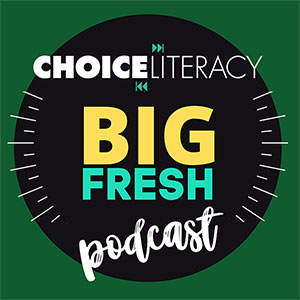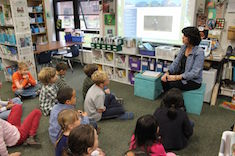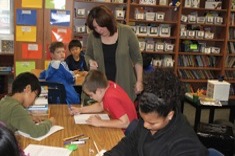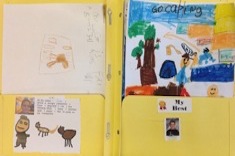Franki Sibberson chats with Jennifer Serravallo about formative assessment in this podcast. Jennifer is the author of The Literacy Teacher’s Playbook, Grades 3-6: Four Steps for Turning Assessment Data into Goal-Directed Instruction. A full transcript is available below the player.

Franki Sibberson: Hi Jenn. Formative assessment is being defined in so many ways right now. How do you define it personally?
Jennifer Serravallo: I think that assessment ahs become a bit of a dirty word. For me, I think it’s the heart of good teaching, and there’s an important difference between the multiple choice, high stakes, quantitative assessment that everyone seems to be quite afraid of right now, and the kind that I think we need more of, which are quality formative assessments. I think of formative assessment as being the kind of assessments that help teachers uncover what students know, and understand what they can do, and the kind that helps teachers plan meaningful, individualized instruction.
Franki: That’s so important and it is so hard right now to embrace that on top of the mandated stuff. So what tips do you have for teacher then for making formative assessment manageable and useful in the classroom?
Jennifer: I think it’s important that it enhances instruction and not detracts from it. So there’s a couple things I try to keep in mind. So first, I think that formative assessments need to match what you want students to do. So for example, if you want students to read whole books during independent reading, ask them to answer questions as they read a whole book. But sometimes I see teachers using a short passage and multiple choice, and then using that data to tell them what to do in a reading conference when kids are reading whole books, and it just doesn’t match. Or if you want to understand how to help your students write well, again, multiple-choice fill-in-the-blank sheet about grammar probably won’t help you with what you do need to know. So I think instead you need to think about what the plan is for instruction, and then have an assessment that’s similar to what you’re going to ask the kids to do everyday. So that’s the first.
The second I think is that formative assessments need to be evaluated so that teachers actually plan for instruction. Too often — I was guilty of this myself, too — but too often I see this kind of assess, score, stack on the desk. It’s like this assess, score, and pile it away cycle, where we’re doing all this collecting, but it’s really a dead end, and then assessments become burdens to the teacher because there’s really no point to that kind of assessment. So instead I think that teachers need to assess only when they have time to and interest in evaluating that assessment and then it has to lead to teaching. So assessments that give us letters or numbers I find often aren’t enough to actually fuel our teaching, and instead, assessments need to uncover nuance of what readers and writers do everyday.
The third principle is that I think that formative assessments shouldn’t take up too much instructional time. This one school I work with in Connecticut that uses a certain commercially published assessment and they spend months several times every year not teaching, and sitting in the corner and assessing, and then at the end of it all they say, “I didn’t really get that much information to teach.” I think a lot of times you don’t need stuff that’s prepackaged. We don’t need to spend tons of time creating it. If we watch kids, if we listen to them read, listen to them talk about their reading, watch what they do, and read what they write in their notebooks, we’ll have a really great, full picture of them. And when we do create assessments, as I said already, they should match what we want them to do, and they should be part of the regular classroom routines and procedures.
So for example, if I want to learn about a student’s conversational skills and figure out what I need to do to support the child in her book club, then I should listen to her during a book club, transcribe what I hear, and then evaluate it for skills and behaviors.
Franki: I love your point about only giving assessments when we have time to look at them afterward, because I think we think about do we have time to give them, but we don’t think, “Ok, do I have some time in the near future to really look hard at those and make some decisions? ” And that’s where you’re right — it’s a big stress and it’s another add-on if we don’t think about it — do we have time to actually analyze them and think about how it will impact instruction?
Jennifer: Yeah and I know for you as an upper elementary teacher, you could look at something that’s a couple weeks old and still get some helpful information, but for a first grade teacher, if it’s a week later, it’s old. You know? You’ve got to have it — I think you have to really quickly evaluate it and do something with it.
Franki: And I find for me if I’m doing some whole class thing like that, I have to do it all in one sitting, or all in one kind of — I can’t do it over a two-week period, because I miss the patterns that I’m seeing across kids. So yeah, that’s a great tip. So your new book on assessment is called The Playbook, which I love. Can you explain how you think about this word as it relates to formative assessment?
Jennifer: Yeah, so first I should admit that everything I know about football comes from my dad, so pretty ____, like, what a _____ —
Franki: ____ helped me with a lot of the metaphors, but —
Jennifer: I think actually I should say since naming it The Playbook and doing research to make the metaphor work in the book, I’ve watched the entire Friday Night Lights series, so I feel a little bit more equipped to —
Franki: The metaphor totally works. [Laughter]
Jennifer: [Laughter] Ok. So in the book, I detail a four-step process that I hope will help teachers collect assessments that are helpful, look at them, and know the content they need to be able to look at them and analyze them, interpret the patterns in the data, and then form a goal and teaching plan. So to me it feels like a bit of a playbook. You know, if you think of a football playbook, it’s the indispensable guide a football coach relies on to know what to do in certain situations.
So for example, football coaches will prepare for Sunday afternoon’s game, or in the case of Friday Night Lights, I guess Friday night’s game, by collecting films of the opposing team’s past games, just like teachers collect examples of student work. Coaches send out scouts to watch the other team play, just like teachers look at their kids in different situations in reading and writing, during word study, and then they talk about what they see with others. Coaches think about their team’s strengths and what play they choose and why, and teachers can think of students’ strengths and what lessons would then be most powerful.
But if a coach just filed the game tapes away and never looked at them, then it could never help their team actually get better, so there’s a lot of analysis that goes into the decision-making, and all of that analysis requires a knowledge of football content. And I think that’s true for teachers, too, and part of why I think teachers sometimes are intimidated by certain assessments or maybe don’t make the time to analyze them, it requires a lot of content knowledge to know what they’re looking at, to know what they’re looking for, and part of what I try to do in this book is offer teachers a lot of look-fors, and a lot of next steps to really unpack the kinds of stories that each type of data tells and what they should be seeing in that.
I also think that the best coaches aren’t random. They plan carefully and they use a lot of strategy. A lot of this is based in having more of a long-range view, so goal setting is important just like it should be in the classroom. So establishing goals of how to deal in certain situations with what individual kids need most, and if I think back on some of the mistakes I made in the beginning when I was a new teacher is that my teaching was very random. I had my kids reading, I had them writing, and as I was conferring with them, I would just kind of pick something, and it wasn’t always the most important thing, and as I shifted to more of a goal-directed workshop, and now as a staff developer helping teachers to do that, the contrast is so stark in how much kids can progress in a year.
So I also wanted to make sure that The Playbook — my book — is about developing an action plan, and this is the last part of it, that there’s game time that happens with football. Playbooks are meant to be used, so I wanted to make sure I helped teachers with establishing a goal, making an action plan both short and long-term, thinking about the message to use to execute that action plan, what kind of follow-up was necessarily, what it would look like once the goal was accomplished, and to be able to track that progress over time.
Franki: I love that. I love that — just your distinction of a goal-directed workshop is not just any goal — I mean just that whole specificity, because I think I look back on my 25 years in workshop and it’s the same thing. I’m getting much better — that goal-directed workshop. I love that word you use, so great. Great metaphor, it totally works — so —
Jennifer: My dad. [Laughter]
Franki: So with all the mandates right now — yeah. [Laughter] How can teachers balance this type of authentic, formative assessment that really does impact our instruction, with all the mandated, more standard assessment that isn’t necessarily a choice right now?
Jennifer: I know, I’m probably not the best person to ask this question of because when I was in the classroom, I was a little bit strong-willed and stubborn — well, I’m still that way I guess — but I was strong-willed and stubborn. And I would speak up.
If I was told to do something, and it didn’t make sense or it didn’t help me, or it took away from me working with my kids or them practicing their reading and writing, I would challenge it, and I would on the grounds of purpose, I would go to my principal and I would say, “Can we talk about this? I want to tell you more about what I’m doing in my classroom, and this thing that I’m being asked to do and how it fits or how it doesn’t, and my ideas for what I would do instead,” and I don’t know if I was lucky or if I chose these principals for these reasons, but I always had principals who would either let me do what I wanted in my classroom because they saw all my kids were working and productive and happy and making progress, or principals who maybe at first didn’t just turn away and let me do whatever, but they were up for a little debate, and after hearing my rationale, would allow me to do what I knew was right for my kids.
And I always had an open door, I invited my administrators into my classroom, and I think that they respected that, and it worked for me, but I know that not every teacher is this lucky to be able to speak up to your administrator and say, “Well, this sounds great, but I’m not going to do it and here’s why.” And even that said, there were some times and some things that even though I didn’t like them, I had to do them — like my state’s annual ELA exam. There was no choice —
Franki: Right I think a lot of state and national mandates are the big ones now.
Jennifer: Yeah, exactly. So it’s like you don’t have a choice there, but I think where teachers do have a choice is to try to not let it overtake everything about their year. Like the pre pre-test and the pre-test and the post-test, and right? And I never found that any of that ever really helped me or my kids, and I just tried to teach all year in authentic ways and devote the smallest amount of time just to teach them how to put bubbles — fill in the bubbles — or a couple of quick multiple choice strategies, but I didn’t really do a ton of test prep, and the result was that the kids who could read well and write well, they did well. The kids who read and wrote far below grade level didn’t do as well, and I would say that the teachers down the hall who did tons of test prep, they ended up having the same results.
So you know, the kids who did well were kids who could read and write, and I just felt like I’d rather spend my year engaged in authentic reading and writing, and there’s so much more you can teach kids, and it’s more joyful that way, I think. So I’m a little stubborn, but — [laughter]
Franki: [Laughter] Well you can do this. So how can we help — as teachers — how can we help parents and communities see the importance of this data that’s not necessarily numbers or quantitative?
Jennifer: I know. Everyone loves numbers. They’re neat, they’re tidy —
Franki: They’re very clear.
Jennifer: You can make color-coded graphs and charts from them, you know, I get it. My dad is an analytical chemist, and I love a standard deviation analysis as much as the next guy, but the problem is that assessments that just give numbers reduce kids to data points, and I think there’s such power in looking at real classroom-based assessments and student work, and being able to describe kids — what they do, what they know, where to take them next — and I think for parents it’s the difference between sitting down in a conference and saying, “Your kid’s a B student,” and being able to describe the work — his interests, his goals, the ways he’s made progress this year and so on.
And I think that every parent — I’m one now, I know I’m sitting on the other end of the table at a parent-teacher conference now, and I appreciate a teacher who knows my daughter well, and is able to describe what she does, not just give a number, give a grade.
Franki: Right. That makes sense.
Jennifer: So maybe with more of these kinds of conferences or report cards that have narratives and descriptions of what kids are doing, maybe parents will start to see the value in that.
Franki: Yeah, I think they do — I think you’re right. So right now, what’s one of your favorite tools or strategies for authentic assessment?
Jennifer: This one’s not really new. I’ve been writing about this since my second book, Teaching Reading in Small Groups, but I think it just comes down to good old kid watching, and I’ve always found such value in stepping back and watching kids while they work, and one of my favorite tools comes from a desire I had as a classroom teacher to understand my kids better in terms of their level of engagement during reading or writing. I knew I could for reading, look at their book log and get a number — I could say, “Oh, they’re reading half as many pages as they should be reading.” But I didn’t know why, and without the why, you don’t really know what you can teach.
So I would watch my kids, and in watching, I was able to find patterns in my class. I could find kids who had a hard time getting settled and started, kids whose stamina seemed to peter out after a short period of time, kids who would spend most of the workshop engaged in avoidance behaviors. I call this tool the engagement inventory, and basically it’s just a class list like the ones you probably have in your clipboard with columns after each name, and I’d watch my kids and record what I saw in five ten-minute increments, and it’s fascinating what you can learn about the behaviors kids are exhibiting and what those behaviors tell you, and more importantly then, what you’re going to do about it and how you’re going to teach.
So I guess that’s what this is all about is I’m just fascinated as I hope teachers are, too, about what you can learn from your kids.







